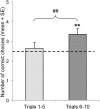Strategies Used by Pet Dogs for Solving Olfaction-Based Problems at Various Distances
- PMID: 26176609
- PMCID: PMC4503413
- DOI: 10.1371/journal.pone.0131610
Strategies Used by Pet Dogs for Solving Olfaction-Based Problems at Various Distances
Abstract
The olfactory acuity of domestic dogs has been well established through numerous studies on trained canines, however whether untrained dogs spontaneously utilize this ability for problem solving is less clear. In the present paper we report two studies that examine what strategies family dogs use in two types of olfaction-based problems as well as their success at various distances. In Study 1, thirty dogs were tasked with distinguishing a target, either their covered owner (Exp 1) or baited food (Exp 2), from three visually identical choices at distances of 0m (touching distance), 1m, and 3m. There were nine consecutive trials for each target. We found that in Exp 1 the dogs successfully chose their owners over strangers at 0m and 1m, but not at 3m, where they used a win-stay strategy instead. In Exp 2 the dogs were only successful in choosing the baited pot at 0m. They used the win-stay strategy at 1m, but chose randomly at 3m. In Study 2, a different group of dogs was tested with their owners (Exp 1) and baited food (Exp 2) at just the 3m distance with two possible targets in 10-10 trials. In Exp 1 the dogs' overall performance was at chance level; however, when analyzed by trial, we noticed that despite tending to find their owners on the first trial, they generally switched to a win-stay strategy in subsequent trials, only to return to correctly choosing their owners based on olfaction in the later trials. In Exp 2, the dogs chose randomly throughout. We also found that dogs who relied on visual information in the warm-up trials were less successful in the olfaction-based test. Our results suggest that despite their ability to successfully collect information through olfaction, family dogs often prioritize other strategies to solve basic choice tasks.
Conflict of interest statement
Figures





Similar articles
-
Canine Olfaction: Physiology, Behavior, and Possibilities for Practical Applications.Animals (Basel). 2021 Aug 21;11(8):2463. doi: 10.3390/ani11082463. Animals (Basel). 2021. PMID: 34438920 Free PMC article. Review.
-
Agility and search and rescue training differently affects pet dogs' behaviour in socio-cognitive tasks.Behav Processes. 2009 Jul;81(3):416-22. doi: 10.1016/j.beproc.2009.03.015. Behav Processes. 2009. PMID: 19520242 Review.
-
Are dogs (Canis familiaris) misled more by their owners than by strangers in a food choice task?Anim Cogn. 2011 Jan;14(1):137-42. doi: 10.1007/s10071-010-0340-y. Epub 2010 Jul 20. Anim Cogn. 2011. PMID: 20644973
-
Does training make you smarter? The effects of training on dogs' performance (Canis familiaris) in a problem solving task.Behav Processes. 2008 Jul;78(3):449-54. doi: 10.1016/j.beproc.2008.02.022. Epub 2008 Mar 16. Behav Processes. 2008. PMID: 18434043
-
Individual differences in social and non-social behaviors in domestic dogs (Canis familiaris) during the acquisition, extinction and reacquisition of a problem solving task.Behav Processes. 2015 Apr;113:179-86. doi: 10.1016/j.beproc.2015.02.002. Epub 2015 Feb 12. Behav Processes. 2015. PMID: 25682735
Cited by
-
A Test of Canine Olfactory Capacity: Comparing Various Dog Breeds and Wolves in a Natural Detection Task.PLoS One. 2016 May 6;11(5):e0154087. doi: 10.1371/journal.pone.0154087. eCollection 2016. PLoS One. 2016. PMID: 27152412 Free PMC article.
-
Individual recognition and long-term memory of inanimate interactive agents and humans in dogs.Anim Cogn. 2022 Dec;25(6):1427-1442. doi: 10.1007/s10071-022-01624-6. Epub 2022 May 5. Anim Cogn. 2022. PMID: 35513745 Free PMC article.
-
A novel task of canine olfaction for use in adult and senior pet dogs.Sci Rep. 2023 Feb 8;13(1):2224. doi: 10.1038/s41598-023-29361-x. Sci Rep. 2023. PMID: 36754988 Free PMC article.
-
Canine Olfaction: Physiology, Behavior, and Possibilities for Practical Applications.Animals (Basel). 2021 Aug 21;11(8):2463. doi: 10.3390/ani11082463. Animals (Basel). 2021. PMID: 34438920 Free PMC article. Review.
-
Using Scent Detection Dogs in Conservation Settings: A Review of Scientific Literature Regarding Their Selection.Front Vet Sci. 2016 Oct 28;3:96. doi: 10.3389/fvets.2016.00096. eCollection 2016. Front Vet Sci. 2016. PMID: 27840815 Free PMC article. Review.
References
-
- Furton K, Myers L. The scientific foundation and efficacy of the use of canines as chemical detectors for explosives. Talanta. 2001;54:487–500. - PubMed
-
- Bijland L, Bomers M, Smulders Y. Smelling the diagnosis A review on the use of scent in diagnosing disease. Neth J Med. 2013;71(6):300–7. - PubMed
-
- Fenton V. The use of dogs in search, rescue and recovery. J Wilderness Med. Elsevier; 1992. August;3(3):292–300.
-
- Wells DL, Hepper PG. Directional tracking in the domestic dog, Canis familiaris. Appl Anim Behav Sci. 2003. December;84(4):297–305.
Publication types
MeSH terms
LinkOut - more resources
Full Text Sources
Other Literature Sources
Miscellaneous

